

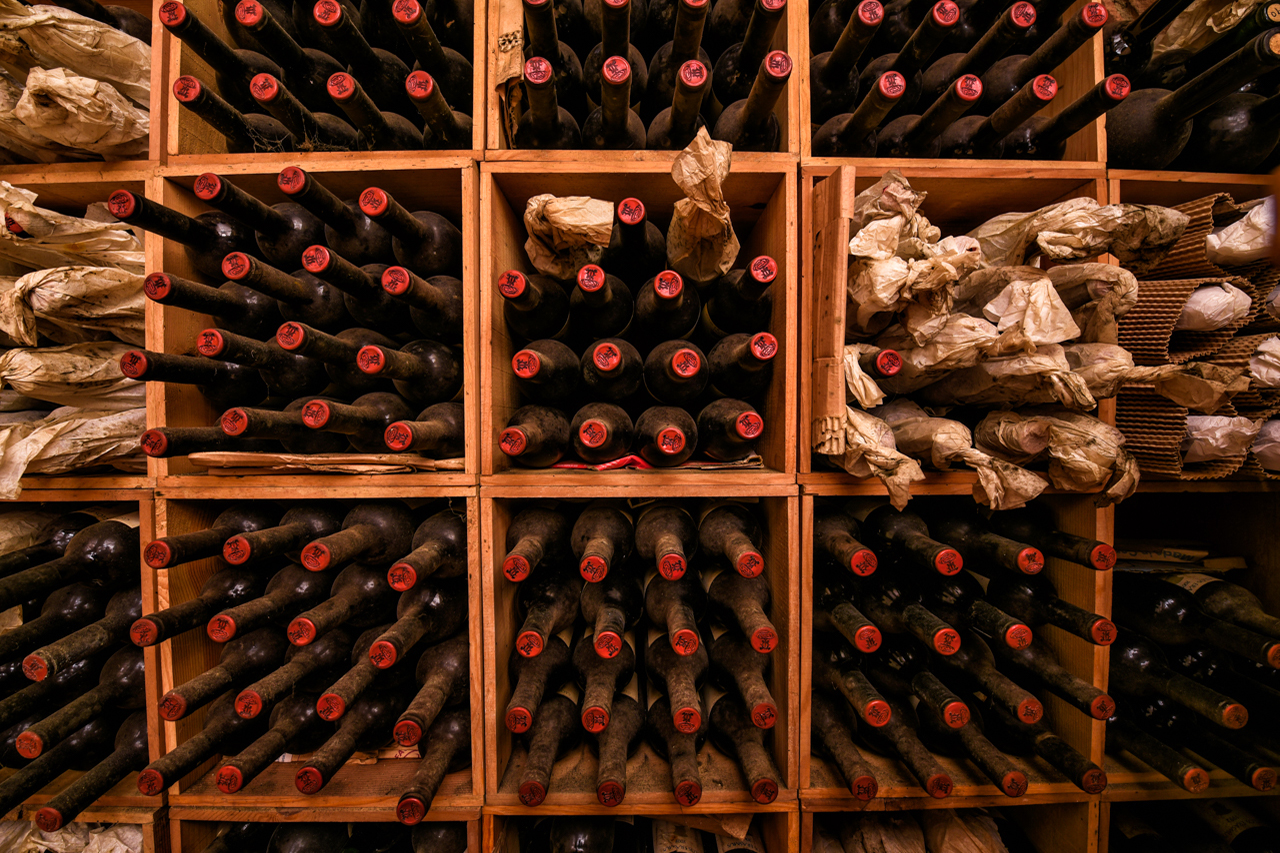
Daphne’s vertical of Clos Erasmus
Daphne Glorian has sent me vintage assessments of Clos i Terrasses since 2014, so I’ve gone through my files, and rather than post each report individually, I’ve put them all in one post. After 20 years of spending time with Daphne and talking about her work, I’ve noticed that she is usually quite reserved about evaluating her wines. She has even stopped writing tasting notes because she feels she cannot be objective. It is often said that the winemaker transcends vintage. In practical terms, I learned this from Daphne long before it became common wisdom. – Steven Spanbauer
Snow! Rains! What a year! After an autumn and winter in 2020 characterized by drought, the storm Filomena ushered the new year with 2 feet of snow in January. This made not only for beautiful pictures of white landscapes but also scenes of frantic winery teams shoveling snow off the roads and trails. As expected, the tales of tractors heroically braving the snow and ice are still told every night at the café. And the year of plenty continued: relatively cool temperatures during the spring and summer produced beautiful, happy grapes. Then, rains at the end of August and September made for a very relaxed harvest. Not having to worry about the grapes over-maturing, we took our time and finished harvesting by October 7th.
Showing a rather different profile, the wines are precise and focused, with some vats finishing at almost one-degree alcohol lower than usual. The wines show a tapestry of cracking red fruits and citrus with a delicate but layered texture, perfect balance, and a very long finish.
 2021 CLOS ERASMUS
2021 CLOS ERASMUSThe grapes come from the same parcels year after year, Escales, Aubagues, and Socarrats, which are fermented and aged separately. Destemmed, sorted by hand, and slightly crushed, the grapes ferment in 10-15 HL wooden vats. The macerations lasted 35-38 days. The malolactic fermentation took place in barrel. The wines were aged in 228L barrels (40% new).
 2021 LAUREL
2021 LAURELLaurel is made from the younger vines of Garnatxa and Syrah, the remaining Cabernet Sauvignon, and an occasional declassified Clos Erasmus barrel. Destemmed, hand sorted, and slightly crushed, it is vinified in wooden and concrete vats and macerated for four weeks. It aged in wooden and concrete vats, third-year 228L barrels, and amphorae. The many different containers add a specific touch to each one of the parcels.
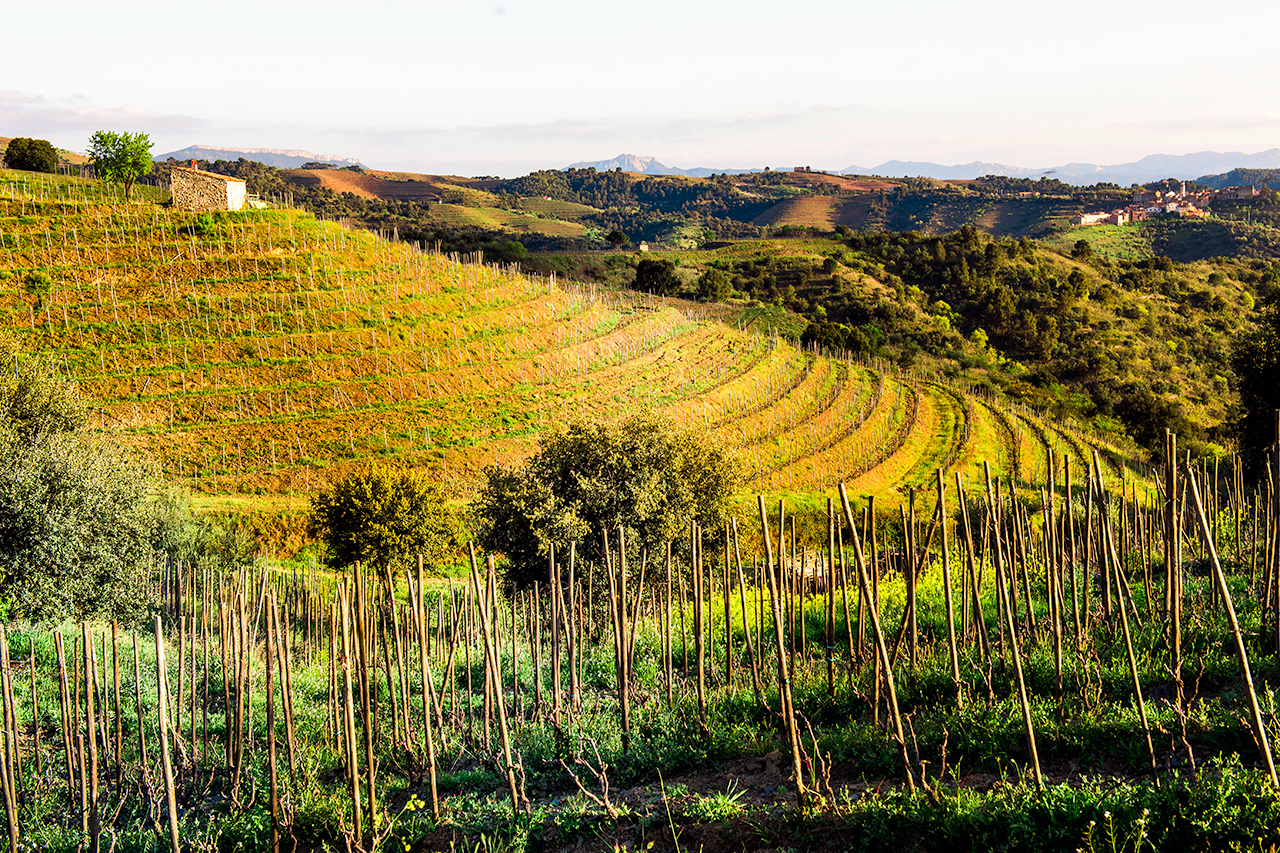
Guinarderes and Gratallops
The 2020 season was one of the most challenging vintages due to a dramatic infestation of mildew, the like of which no one in the Priorat remembers having ever seen. The mild spring temperatures and constant rains during the growing season created the perfect conditions for fungus, but the virulence of the strain took everyone by surprise. With so much humidity in the air, the first signs of fungus in May were expected, but by June, it was obvious that we were dealing with a particularly nasty phenomenon. The wines are a perfect example of Mediterranean varieties producing their best under challenging conditions. They are concentrated, solar, and yet velvety, with a strong will but happy demeanor.
One of the many advantages of farming organically is that we are highly vigilant and aim to prevent diseases and stop them before they have time to take root and spread. My team did a fantastic job; no parcel was left unattended for more than three days, and the constant attention kept the plague mostly at bay. Then, in July, the weather finally turned sunny and dry, and the wind cleaned the leaves of remaining spores. By harvest time, it was clear that the effort had paid off; everyone was exhausted, but we lost barely 10% of the crop.
The harvest started slightly early, as the grapes ripened quickly, and the fermentations went smoothly. The resulting wines show not only their roots but an exceptionally intense character, almost ethereal, of white flowers and red fruit—the 2020 vintage dances in the glass.
 2020 CLOS ERASMUS
2020 CLOS ERASMUSThe grapes come from the same parcels year after year, Escales, Aubagues, and Socarrats, which are fermented and aged separately. Destemmed, sorted by hand, and slightly crushed, the grapes ferment in 10-15 HL wooden vats. The macerations lasted 35-38 days. The malolactic fermentation took place in barrel. The wines were aged in 228L barrels (40% new).
 2020 LAUREL
2020 LAURELLaurel is made from the younger vines of Garnatxa and Syrah, the remaining Cabernet Sauvignon, and an occasional declassified Clos Erasmus barrel. Destemmed, hand sorted, and slightly crushed, it is vinified in wooden and concrete vats and macerated for four weeks. It aged in wooden and concrete vats, third-year 228L barrels, and amphorae. The many different containers add a specific touch to each one of the parcels.
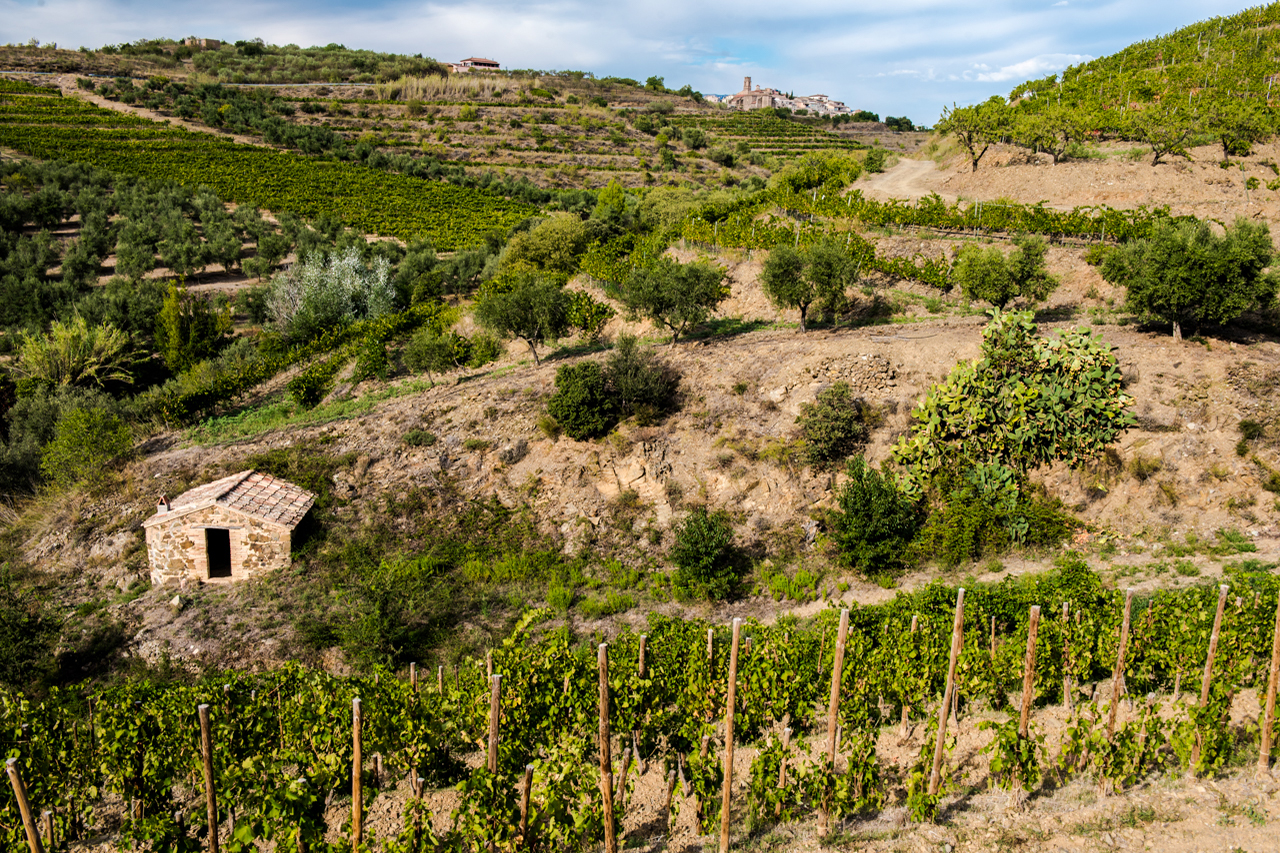
Aubages vineyard, view from the top of the hill looking towards Gratallops
2019 was a dramatic change from 2018, with little rain during the winter (less than 136 liters between January and September), resulting in a drought compounded by an unheard-of heatwave in June, with temperatures reaching 42 degrees (107 F.) for almost a week. But trust the vines of the Priorat. Even though the extreme temperatures of June hit them hard, they are used to harsh conditions and adapted, returning to their normal thrifty mode.
The resulting volumes were, of course, almost 20% below those of 2018 but in line with the yields we often get, 18-19 hectolitres per hectare. Harvest began at the end of August with Syrah and finished only a day earlier than average on September 18th. As expected, low yields and high temperatures speeded up the ripening process. The wines are a perfect example of Mediterranean varieties producing their best under challenging conditions. They are concentrated, solar, and yet velvety, with a strong will but happy demeanor.
 2019 CLOS ERASMUS
2019 CLOS ERASMUSThe grapes come from the same parcels year after year, Escales, Aubagues, and Socarrats, which are fermented and aged separately. Destemmed, sorted by hand, and slightly crushed, the grapes ferment in 10-15 HL wooden vats. The macerations lasted 35-38 days. The malolactic fermentation took place in barrel. The wines were aged in 228L barrels (40% new).
 2019 LAUREL
2019 LAURELLaurel is made from the younger vines of Garnatxa and Syrah, the remaining Cabernet Sauvignon, and an occasional declassified Clos Erasmus barrel. Destemmed, hand sorted, and slightly crushed, it is vinified in wooden and concrete vats and macerated for four weeks. It aged in wooden and concrete vats, third-year 228L barrels, and amphorae. The many different containers add a specific touch to each one of the parcels.
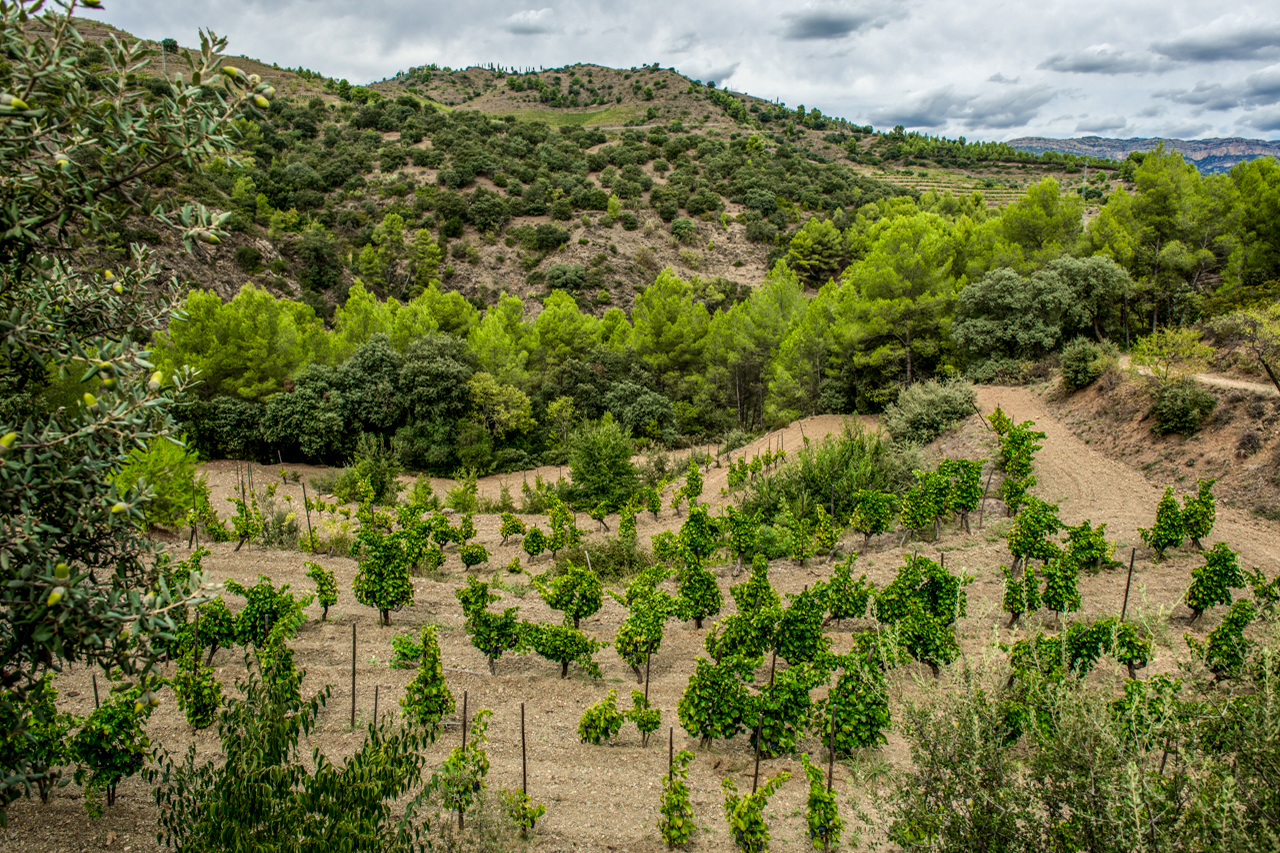
Escales vineyard – Daphne’s original vineyard
The 2018 vintage started very well, with frequent rains from January through May, with even a snowy episode in March. The view of the Montsant dusted with snow that morning was gorgeous, if unexpected. The fruit set produced a riot of grapes, which were sustained through the summer thanks to a couple of showers despite temperatures climbing up steadily. Even though August was very hot, as often in the Priorat, the breezes blowing from the Mediterranean kept the plants cool enough to support maturing the grapes consistently.
By the end of summer, it was clear that we had an amazing harvest ahead of us, with the grapes being not only perfect but plentiful. This was the first time we reached 21 hectolitres per hectare. As a result, the wines are fresh and vibrant, with a perfect balance of crisp fruit and acidity and a bright color.
 2018 CLOS ERASMUS
2018 CLOS ERASMUSThe grapes come from the same parcels year after year, Escales, Aubagues, and Socarrats, which are fermented and aged separately. Destemmed, sorted by hand, and slightly crushed, the grapes ferment in 10-15 HL wooden vats. The macerations lasted 35-38 days. The malolactic fermentation took place in barrel. The wines were aged in 228L barrels (50% new).
 2018 LAUREL
2018 LAURELLaurel is made from the younger vines of Garnatxa and Syrah, the remaining Cabernet Sauvignon, and an occasional declassified Clos Erasmus barrel. Destemmed, hand sorted, and slightly crushed, it is vinified in wooden and concrete vats and macerated for four weeks. It aged in wooden and concrete vats, third-year 228L barrels, and amphorae. The many different containers add a specific touch to each one of the parcels.
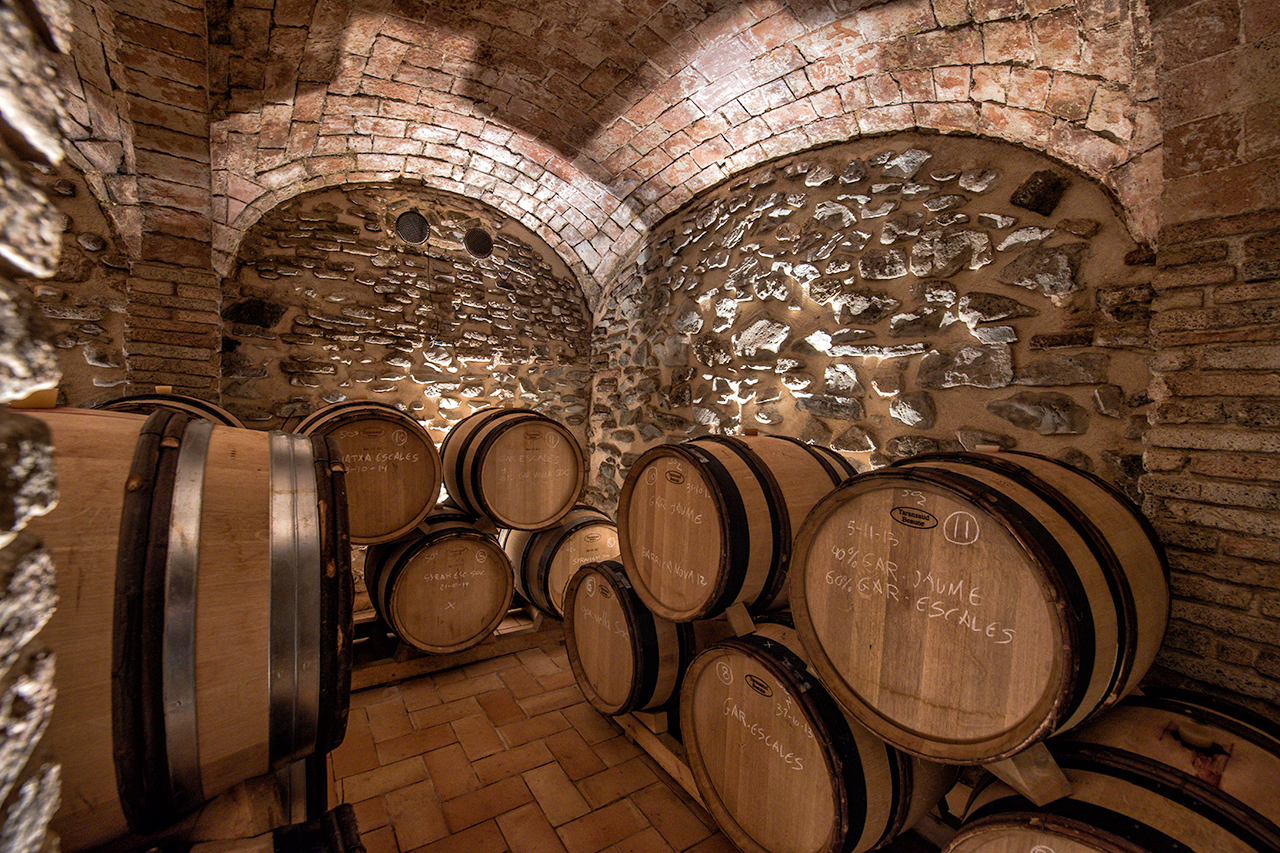
Clos Erasmus barrel room
The 2017 vintage started well, with rains throughout winter, and while they were not abundant, they offered relief after a very dry 2016. Lower-than-average temperatures in winter were also very welcome. By Spring, however, the conditions returned to the new normal, with precipitation becoming scarce and temperatures slightly higher than average. These conditions not only lasted through the summer, but they only intensified. Our only salvation was the humid breezes from the Mediterranean Sea – the only source of hydration being absorbed by the plants through their leaves rather than their roots.
Once again, the importance of giving the soil maximum attention cannot be overstated. Its ability to retain moisture is becoming more critical than ever. By the end of summer, the grapes were small but beautiful. The fermentations proceeded without significant surprises, to our relief, after the worries of the summer.
The wines are a perfect example of Mediterranean varieties producing their best under challenging conditions. They are concentrated, solar, and yet velvety, with a strong will but happy demeanor. Light in color than previous vintages and with greater floral complexity layered above a core of ripe red fruit flavors.
 2017 CLOS ERASMUS
2017 CLOS ERASMUSThe grapes come from the same parcels year after year, Escales, Aubagues, and Socarrats, which are fermented and aged separately. Destemmed, sorted by hand, and slightly crushed, the grapes ferment in 10-15 HL wooden vats. The macerations lasted 35-38 days. The malolactic fermentation took place in barrel. The wines were aged in 228L barrels (40% new).
 2017 LAUREL
2017 LAURELLaurel is made from the younger vines of Garnatxa and Syrah, the remaining Cabernet Sauvignon, and an occasional declassified Clos Erasmus barrel. Destemmed, hand sorted, and slightly crushed, it is vinified in wooden and concrete vats and macerated for four weeks. It aged in wooden and concrete vats, third-year 228L barrels, and amphorae. The many different containers add a specific touch to each one of the parcels.
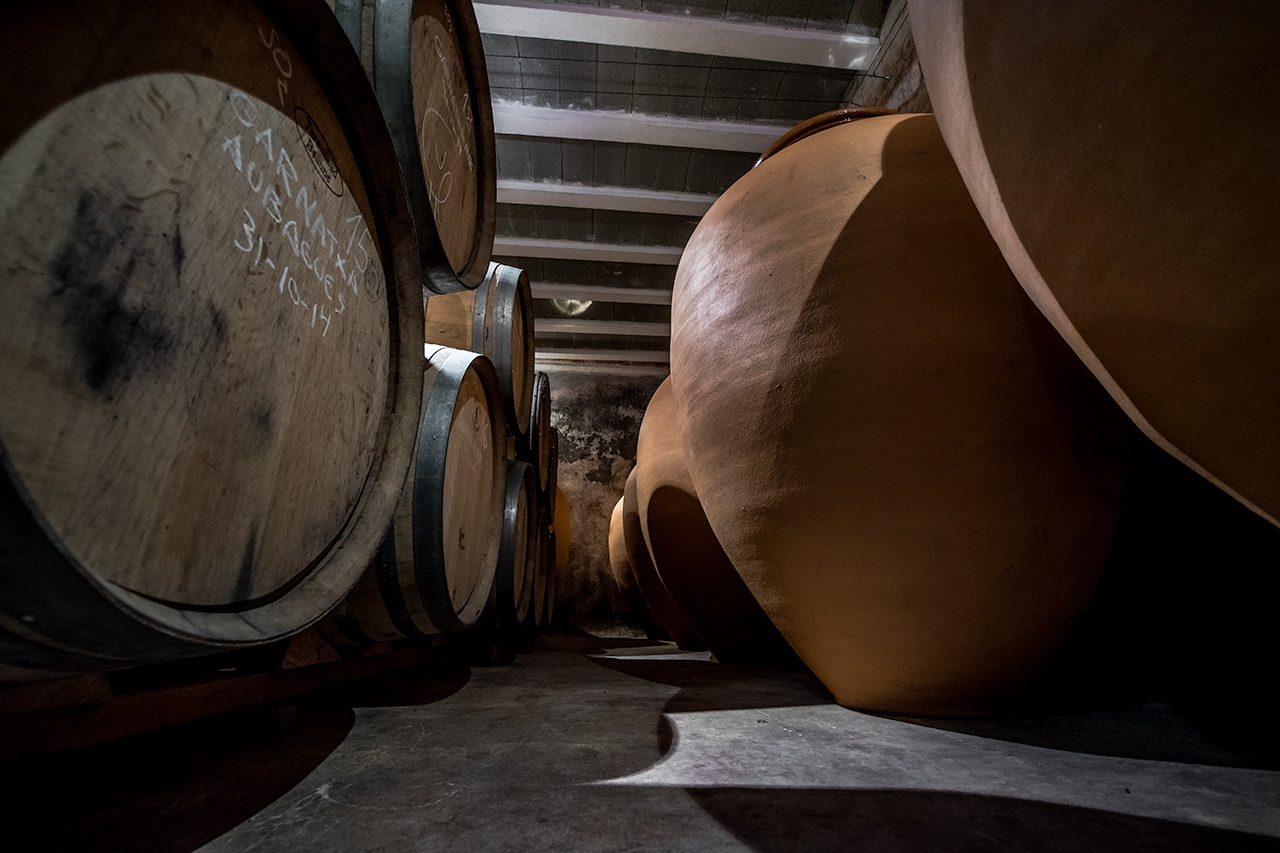
Laurel aging cellar
The 2016 vintage distinguished itself again by drought and high temperatures. Unfortunately, the winter rains, so crucial for the vine’s recovery after the previous harvest, were relatively scarce. Fortunately, we had some precipitation in spring, and the vines banked on this during summer, which turned out to be very dry and hot. The phenomenon we have observed in the last ten years seems to be the new normal: very high temperatures at the end of August and into the first two weeks of September. More important and more drastic are the nocturnal temperatures in August. In 2016, they remained above 20 degrees night after night in mid-August, while in the past, they usually dropped into the mid-teens.
These new circumstances forced us to dedicate more attention than ever to the soil. The importance of retaining moisture is critical to the health of the vineyards. We use high quantities of compost/hummus to protect the vines from direct heat.
The drought created tiny but healthy berries with a strong character. The fermentations marched steadily, every vat consuming its sugars with a dogged determination. They were all done within 20 days. The results are wines of electric quality. A sharp focus, tension, and liveliness are the defining characteristics of this vintage.
 2016 CLOS ERASMUS
2016 CLOS ERASMUSThe grapes come from the same parcels year after year, Escales, Aubagues, and Socarrats, which are fermented and aged separately. Destemmed, sorted by hand, and slightly crushed, the grapes ferment in 10-15 HL wooden vats. The macerations lasted 35-38 days. The malolactic fermentation took place in barrel. The wines were aged in 228L barrels (40% new).
 2016 LAUREL
2016 LAURELLaurel is made from the younger vines of Garnatxa and Syrah, the remaining Cabernet Sauvignon, and an occasional declassified Clos Erasmus barrel. Destemmed, hand sorted, and slightly crushed, it is vinified in wooden and concrete vats and macerated for four weeks. It aged in wooden and concrete vats, second and third-year 228L barrels, and amphorae. The many different containers add a specific touch to each one of the parcels.
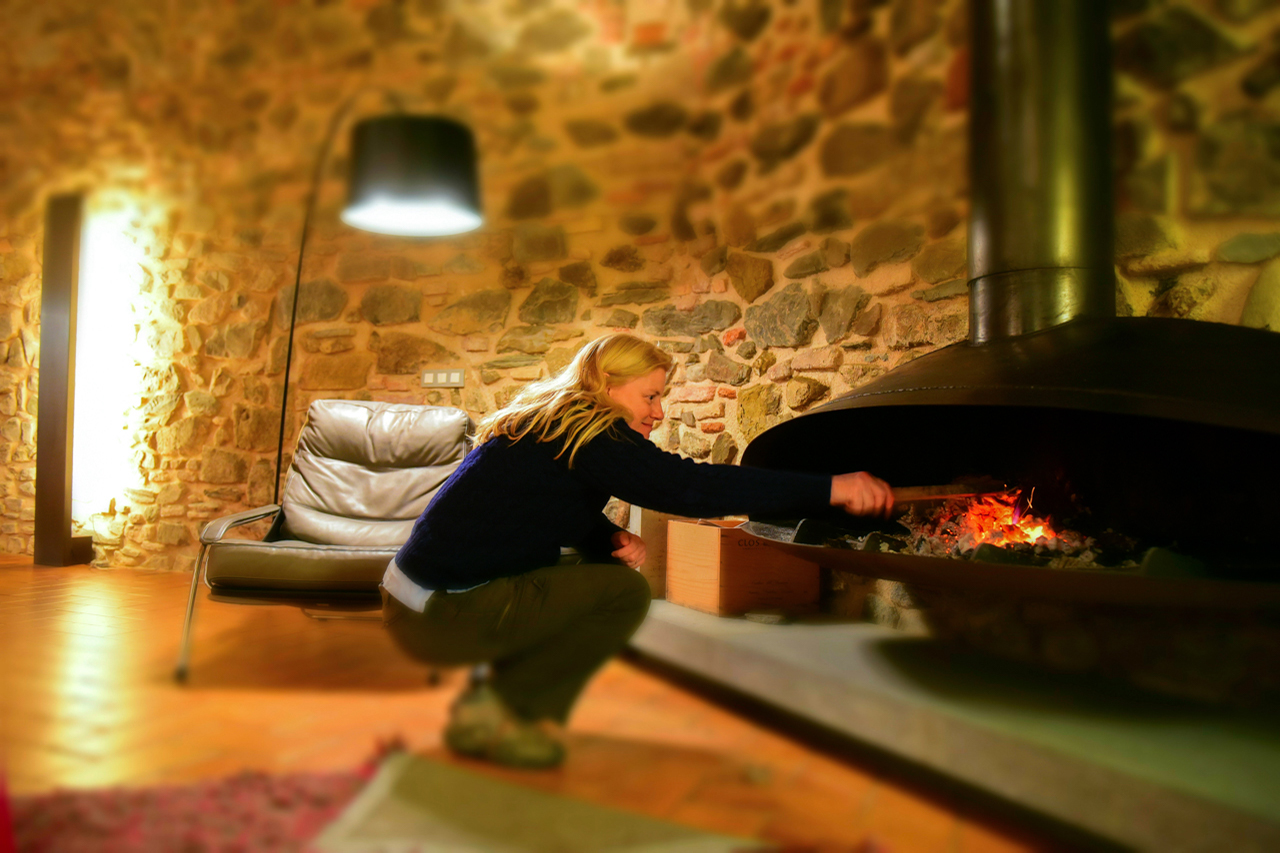
Daphne at home in Gratallops
For the most part, 2015 was a stress-free vintage. The autumn of 2014 brought sufficient precipitation, and 2015 began with milder temperatures than average, which became the hallmark of the vintage, along with drier conditions – about 25% less precipitation than average. February was the exception to this trend when we experienced low temperatures and even a day of snow! This slowed down the growth of the vines, but in March, the tendency towards warmer weather resumed, and by the beginning of April, the heat was on. By July, the temperatures reached 42 degrees Celcius. I was bracing myself for an early harvest when we finally got some relief – a miraculous rain at the end of July saved the vintage. The vines got a second wind, and the rest of the summer proceeded normally with healthy grapes and even ripening. Yields were smaller than in 2013 and 2014, and the finished wines reflect the season perfectly with a darker fruit character than in the three previous vintages with ripe, dense tannins but subtle and balanced.
 2015 CLOS ERASMUS
2015 CLOS ERASMUSThe grapes come from the same parcels year after year, Escales, Aubagues, and Socarrats, which are fermented and aged separately. Destemmed, sorted by hand, and slightly crushed, the grapes ferment in 10-15 HL wooden vats. The macerations lasted 35-38 days. The malolactic fermentation took place in barrel. The wines were aged in 228L barrels (50% new).
 2015 LAUREL
2015 LAURELLaurel is made from the younger vines of Garnatxa and Syrah, the remaining Cabernet Sauvignon, and an occasional declassified Clos Erasmus barrel. Destemmed, hand sorted, and slightly crushed, it is vinified in oak and concrete vats as well as an assortment of small containers of various sizes and materials depending on the necessity of the moment. It aged in wooden and concrete vats, second and third-year 228L barrels, and amphorae. Although this looks rather eclectic and haphazard, I like the mix of different vessels as it gives me all sorts of ingredients for the final blend.

Daphne at home in Gratallops in the early 1990s
To everyone´s satisfaction, the winter of 2013/2014 was as generous as the previous one. This was good news, as the vineyards were still reeling from the extremely dry vintages of 2011 and 2012. From November through April, we had abundant rains, but the temperatures were mild. The vines stayed on schedule; the budding and fruit set took place without issues. The summer was dry, but the mean temperatures remained relatively cool, with none of the intense heat we often experience in July or August, thereby avoiding hydric stress. A few rains in early September kept the process going slowly and evenly through the end of harvest on September 24th. These conditions created a healthy, balanced, and relatively plentiful crop.
The alcoholic fermentations were relatively rapid by the standards of the winery, 15 to 25 days. The 2014 is a slightly later bloomer than the 2013, more reserved and subtle at first. Still, its complexity and strength pull you in unexpectedly like an undertow current – a fascinating vintage with a promising future.
 2014 CLOS ERASMUS
2014 CLOS ERASMUSThe grapes come from the same parcels year after year, Escales, Aubagues, and Socarrats, which are fermented and aged separately. Destemmed, sorted by hand, and slightly crushed, the grapes ferment in 10-15 HL wooden vats. The macerations lasted 35-38 days. The malolactic fermentation took place in barrel. The wines were aged in 228L barrels (60% new).
 2014 LAUREL
2014 LAURELLaurel is made from the younger vines of Garnatxa and Syrah, the remaining Cabernet Sauvignon, and an occasional declassified Clos Erasmus barrel. Destemmed, hand sorted, and slightly crushed, it is vinified in wooden and concrete vats and macerated for four weeks. It aged in wooden and concrete vats, second and third-year 228L barrels, and amphorae. The many different containers let the individual parcels playfully express themselves.